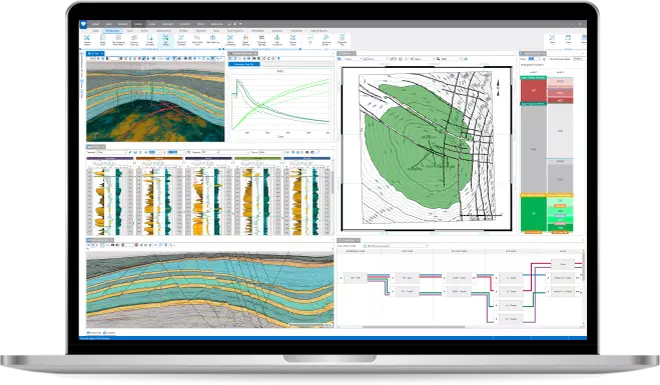JewelSuite Subsurface Modeling v2024 crack license download

JewelSuite Subsurface Modeling v2024 - cracked download free made easy,full crack descargar
JewelSuite Subsurface Modeling v2024 crack license download JewelSuite Subsurface Modeling is an innovative, powerful application to quickly create precise geological models, regardless of a reservoir’s structural complexity.crackeddownload.com
JewelSuite Subsurface Modeling v2024 crack license download
JewelSuite Subsurface Modeling is an innovative, powerful application to quickly create precise geological models, regardless of a reservoir’s structural complexity. The application has all of the functionality and tools you need to go from importing and interpreting your raw seismic and well data, to creating a variety of models that allow you to generate a grid model that can be used as input for reservoir simulation and volumetric reporting.JewelSuite Subsurface Modeling provides everything you need to build complex reservoir models, from tools to refine your seismic interpretation to static and dynamic reservoir modeling and well planning. Tools for automating these tasks are also available. These automation tools allow you to more efficiently apply your geological insight as they provide a means of quickly changing or tweaking models, which greatly aids in iterating through various scenarios in the field you are studying.

The patented JewelGrid technology allows you to create highly accurate and realistic representations of the subsurface. You can visualize your seismic data, geological data, and simulation model data in great detail throughout the modeling process, and interactively use the comprehensive set of editing tools to fine tune your models.
JewelSuite Subsurface Modeling v2024
Various industry-standard simulators are supported, so you can use the most appropriate simulator for the task at hand. Tight integration with these simulators allows you to develop, refine, and receive the results of your simulation all while working exclusively within the application’s user interface.
The application, as a member of the JewelSuite family of products, is an open framework that allows add-in creators and other third parties to add to the functionality and resources available to you.
JewelSuite Subsurface Modeling is a software application that is developed on the JewelEarth Platform. This subsurface reservoir and well-focused software platform provides you with the capability to rapidly create add-ins or complete standalone applications. Using JewelSuite Subsurface Modeling you can visualize any solution created within the JewelSuite family of products, allowing you to study and compare modeling scenarios.
You can also import your solution into other applications such as JewelSuite GeoMechanics, where additional work can be performed. An overview of things you can do with the application is given below.
JewelSuite Subsurface Modeling v2024 Importing and exporting data
You can import a wide variety of reservoir data, including many commonly used formats for which streamlined importing processes have been developed. When importing seismic data and/or seismic interpretation data in the time domain, time/depth conversion can be performed using the available domain conversion tools. You can access databases, to connect to or to import multiple well data files from applications commonly used in the industry. You can also export data in many formats to reuse in other applications. For details on exactly what files you can import and export, see File formats for importing and exporting data.
JewelSuite Subsurface Modeling v2024 Preparing data for modeling
Data interpretations are organized in event types, where events describe a boundary. This can be a stratigraphic, a structural or a fluid boundary. An event can contain one or more graphical representations, e.g. markers and tri-meshes. Before you use your data as input for any model, you must organize your data in a ‘data container’. Such a data container can either be a seismic interpretation, or a surface set. Working with data containers ensures data consistency throughout the modeling workflow. You can assign events from alternative sources. The work from people working in multiple disciplines comes together in the stratigraphic model.
The stratigraphic model links the stratigraphy of the units defined in the model area to the available data describing the bounding surfaces between those units. The stratigraphic model uses hierarchy in the form of stratigraphic levels. Hierarchical levels in the stratigraphic model support the lithostratigraphic concept commonly known as the Group-Formation-Member relationship. The hierarchical concept has great advantages during various modeling stages:
Stratigraphy is hierarchical, which can be reflected in the stratigraphic model. Higher order units constrain the lower order units during construction of the internal zonation of the 3D geological model.
Well correlation is more robust; lower order units are typically identified during (local) well correlation and can be placed in the context of higher order seismic (regional). Interpretations; structural modeling can be performed in stages: higher order stratigraphic units (seismic resolution scale) can be created first, allowing early QC steps and giving control over data resolution, before adding more detail in the form of flow simulation models.
JewelSuite Subsurface Modeling v2024 Perform well correlation
You can quickly and easily correlate wells based on well log data. Correlated wells can be used to map surfaces throughout the reservoir to create a fine-scaled and accurate representation of geological features. Surface intersections can be calculated between wells and surfaces to compare the intersections with the available log data. You can easily correct mismatches with the well matching functionality to ensure full consistency between wells, surfaces and log data.
Structural modeling
You can build a 3D structural model based on a fault model in combination with the well markers and the vertical zonation defined in the stratigraphic model. Structural modeling can be performed in stages, with higher order units modeled first, allowing QC steps to be performed at an early stage. Advanced automated and manual editing tools help you quickly clean-up the structural surfaces to produce a structural model. Different stratigraphic and fault models can be combined to create multiple structural model scenarios, which can serve as the input for building geological reservoir models.
